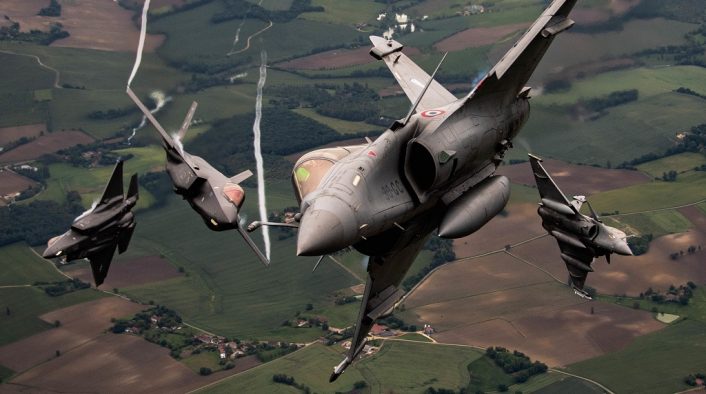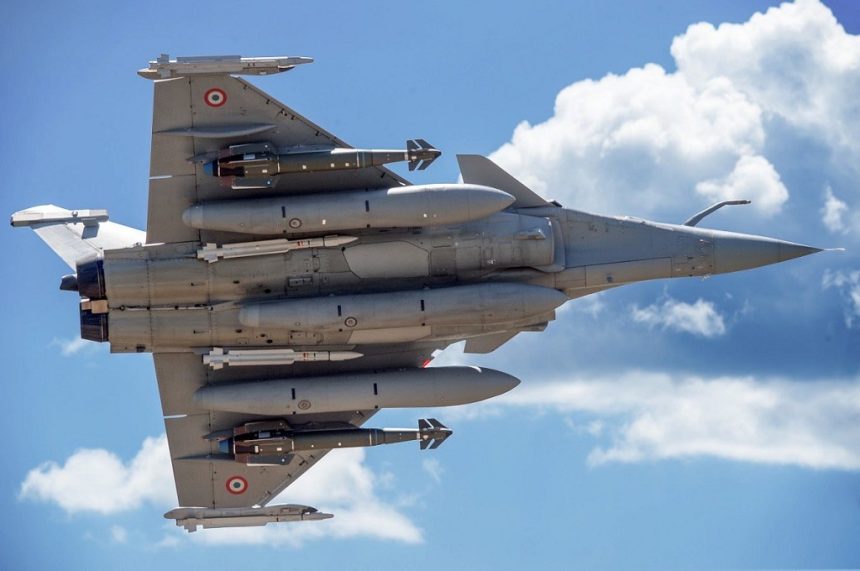The new F4-1 standard will upgrade the Rafale capabilities introduced with the F3-R standard, as well as adding some new important ones.
The French Directorate General for Armaments (DGA) announced last week that it has begun the testing of the new Rafale F4-1 standard at the end of April. The first flight test campaign took place in Istres at the DGA flight test centre, where eight complex missions were flown, involving 50 individual aircraft sorties, from April 26 to 29.
The French Air and Space Force, the French Navy and Dassault Aviation took part in the flight test campaign, deploying six Rafale B/C, two Rafale M, two Mirage 2000 C and two Alphajet trainers, together with the Navy’s daily training assets of the Mediterranean area and DGA ground resources as specific air test controls, listening rooms and tracking systems. Dassault, Thales and MBDA helped monitor the data from the test flights in real time, also collecting the feedback from the flight crews to help the continuation of the development.
#France begins flight trials of F4-standard @Dassault_OnAir #Rafale. Some functions set to enter service in 2022, with wider configuration being rolled out about 2025. Is the latest in up to 7 enhancement packages designed to take jet out to 2070! https://t.co/ogrYDxef6G pic.twitter.com/7d9KJ4EgHN
— Gareth Jennings (@GarethJennings3) May 21, 2021
According to the DGA’s press release, the flight test campaign allowed two upgraded Rafale F4-1 to be included in a large-scale scenario, with up to eight aircraft involved in the tactical phases of the missions. This resulted in a more realistic environment where the crews also implemented unspecified collaborative combat functionalities to localize adversaries by passive means. The passive mean mentioned should most probably be the OSF (Optronique secteur frontal/ frontal sector optronics), the InfraRed Search and Track (IRST) installed on the nose of the Rafale, in front of the cockpit.
The development of the Rafale F4 standard started in early 2019, when the contract for the new upgrade was notified by the Ministry of Defense soon after the certification of the F3-R standard. “This standard is based on four pillars: connectivity, engagement, availability, and the detection and fight against threats,” said the Minister of the Armed Forces in that occasion. “This F4 standard is a technological leap, an industrial leap, a strategic leap.”
RAFALE F4 First French Air Force and Navy evaluation https://t.co/ABopeJbJ5L some nice pictures to see again and again #rafale #avgeeks #F4 #military #ops #nextstep #minarm #rafaleteam #defense #France #Egypt #Qatar #India #Greece #HXhanke #fighter #flightest #roadmap #mil #photo pic.twitter.com/PbRzTGDed9
— BOECKLER Fred (@BOECKLERFred) May 21, 2021
According to the DGA, improving the connectivity of the Rafale and the associated networked employment methods, both in a national and allied context, is the primary goal of the F4 standard. The new standard will be the first step towards the networked multi-platform capabilities of the future Système de Combat Aérien Futur (SCAF).
As for the availability, the Rafale F4 will include a new Prognosis and Diagnostic Aid System, introducing predictive maintenance capabilities, and a new engine control unit, while other maintenance optimization features scheduled will include solutions based on Big Data and artificial intelligence.

The F4 standard will include upgrades of existing capabilities, like the Thales RBE2 Active Electronically Scanned Array (AESA) radar, the Spectra (Système de Protection et d’Évitement des Conduites de Tir du Rafale or, in English, Self-Protection Equipment Countering Threats to Rafale Aircraft) electronic warfare system, the OSF IRST, the Thales Talios targeting pod, the Reco NG reconnaissance pod and the communications suite. However, there will be also important new capabilities, like the Thales Scorpion Helmet Mounted Display (HMD), the MICA NG (Next-Generation) air-to-air missile and the new 1000 kg variant of the Safran AASM (Armement Air-Sol Modulaire) “Hammer” Precision-Guided Munition (PGM).
The HMD is a long-waited capability for the Rafale. Initially, the Sagem Gerfaut HMD was chosen in the early 2000s to equip the Rafale, however the program was later dropped. According to reports, Qatar and India asked for an HMD on their aircraft, so the Elbit Targo II was integrated on the Rafale. France, however, chose to integrate the Scorpion, with a first test campaign carried out in Cazaux during March 2021, preceded by parachute compatibility tests to verify that the new helmet is safe for the pilot in the event of an ejection.
#Matériel Cette année, le centre d’expertise @DGA Essais en vol a réalisé, sur le site de Cazaux, des essais de compatibilité du viseur de casque Scorpion de @thalesgroup avec l’évacuation en parachute d’un pilote de Rafale. pic.twitter.com/4G6PxmcmIk
— Armée de l’Air et de l’Espace (@Armee_de_lair) March 31, 2021
The MBDA MICA (Missile d’interception, de combat et d’autodéfense, “interception, combat and self-defence missile”) NG will be the successor of the current MICA already used by the Rafale, with the phase-out of the older missile and certification of the operational capability of the newer one expected around 2030. “Like the current MICA missile, the MICA NG will be developed in two versions: infrared and electromagnetic seeker. It will use the interface and mechanical characteristics of the current Mica in order to facilitate its integration into the Rafale. Its range is extended thanks to the use of “bi-pulse” thruster which also gives it better maneuverability in the terminal phase”, said the Minister of the Armed Forces. The MICA NG will be used alongside the Meteor BVRAAM (Beyond Visual Range Air-to-Air Missile).
As for the 1000 kg AASM, the new variant will see the AASM kit applied on the BLU109 penetrator warhead or the standard Mk-84, according to the mission’s needs. The first separation tests were performed in December 2020 at the DGA Flight test center in Cazaux. The new AASM variant will have also a specific range increase kit to extend its stand-off firing range and is expected to be certified by 2022. The Rafale will be able to carry up to three of these bombs, of which one under the fuselage and two under the wings, similarly to the already certified GBU-24 Paveway III.
The Rafale F4 standard will be fielded in two stages, in 2022 and 2024, in order to have the new capabilities operational as soon as they are certified. The next test campaign, again at the DGA Flight Test Centre in Istres, will assess the F4-1 capabilities during air-to-ground missions.
The news about the Rafale F4 testing come in the same days of the first photos of the first Greek Rafale and the order by Croatia. Greece announced last year the acquisition of 18 Rafale F3-R, of which some will be newly built while the majority will be second-hand aircraft from the French Air Force, to replace the oldest Mirage 2000 currently in service in the Hellenic Air Force. The Croatian Air Force will acquire 12 Rafale F3-R, this time all second-hand aircraft, to replace the 12 MiG-21bis currently in service, but negotiations are still in progress and a delivery date has not been disclosed.
Την ημέρα που η Ελλάδα και η ΠΑ τιμούν τον Σμηναγό Κώστα Ηλιάκη έρχονται στη δημοσιότητα οι πρώτες φωτό του πρώτου Ελληνικού Rafale…🇬🇷👍🇬🇷👍🇬🇷👊🇬🇷👊🇬🇷@HAFspokesman pic.twitter.com/6xMZ8XCtJU
— Kostas Sarikas 🇬🇷 (@SarikasKostas) May 23, 2021
PVRH @AndrejPlenkovic: Odabrana je 🇫🇷 ponuda jer za najpovoljniju cijenu 🇭🇷 dobiva najbolje ocijenjen i opremljen avion – Rafale F3-R, u najnovijem standardu. To znači da ćemo raspolagati najnaprednijim borbenim zrakoplovom u ovom dijelu Europe. #sjednicaVRH
📸@Dassault_OnAir pic.twitter.com/S2PYPrMj3O
— Vlada Republike Hrvatske (@VladaRH) May 28, 2021









